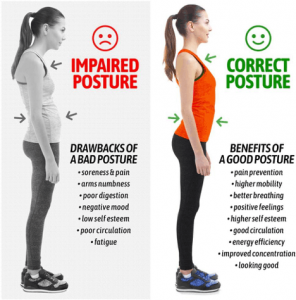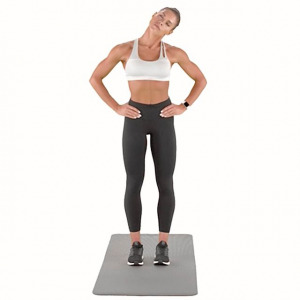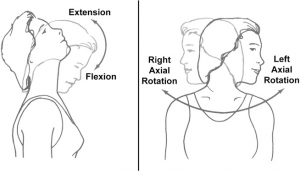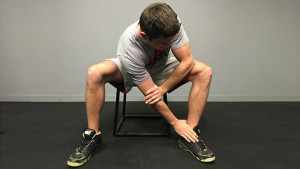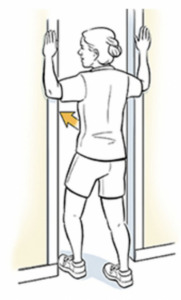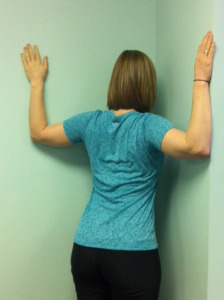Listen up, ladies and gents, because I’m about to let you in on a secret. What if I told you that one simple trick could totally transform your physical, mental, and emotional well-being – and you wouldn’t have to spend a dime?
Are you sitting down? Good, because here’s the secret trick: Sit up straighter.
Yep, we’re talking about practicing good posture – that is, positioning yourself with a neutral spine. Good posture means that whether you’re sitting, standing, or lying down, your head should be above your shoulders, your shoulders should be back and relaxed, and the top of your shoulders should be in alignment with your hips.
You probably already know that there’s some purpose to good posture – after all, how many times did your mother scold you not to slouch? Maintaining proper posture, of course, helps keep your spine in alignment, which takes the pressure off your joints and provides relief from back and neck pain (or prevents it from happening in the first place). But the benefits of avoiding the dreaded “tech neck” don’t stop there, and they’re probably more wide-ranging than you think.
The Benefits Of Good Posture
In addition to reducing your risk of pain and tension headaches, proper posture can help increase your lung capacity, says Dr. Matt Tanneberg, a sports chiropractor and certified strength and conditioning specialist. “Think of your lungs like balloons. With bad posture, you are putting more and more pressure onto your lungs, limiting how much they are able to expand during a deep inhale,” he says. “Being a chronic sloucher will lead to decreased lung capacity, which in turn will decrease your athletic output.”
Not too worried about athletic ability? How about your emotional and mental health? “Good posture helps improve your breathing by aligning your spine and opening up your chest. This can help to decrease the amount of stress on your body and make it easier for you to take deep, relaxing breaths,” explains Dr. Harold Hong, a board-certified psychiatrist. “When you feel stressed, your body tends to tense up, leading to shallow breathing that can exacerbate anxiety and panic attacks. Proper breathing helps reduce stress and relax the muscles, leading to improved mental clarity and focus,” he says.
According to the results of one randomized controlled trial, “Adopting an upright seated posture in the face of stress can maintain self-esteem, reduce negative mood, and increase positive mood compared to a slumped posture.” Additional research suggests that, in people who already report mild-to-moderate depression, upright posture can improve affect, reduce fatigue, and decrease anxiety.
6 Everyday Posture Exercises
Good news: It’s never too late to perfect your posture. While purchasing a posture corrector or ergonomic chair is one way to do it, the most effective (and free!) approach is to isolate and train the muscles responsible for keeping you upright.
Finally convinced to stand up against slouching? Do we have a routine for you! Stop the hunched-over texting, take a few deep breaths, and get ready to move your body – because here, Tanneberg shares six simple posture exercises you can practice every day to supercharge your stance.
1. Lateral Flexion
In a seated or standing position, bring your ear to your shoulder, and stretch as far as you can without pain. If the stretch is too painful, pull back on the stretch. Hold for 15 seconds. Perform 2 repetitions on each side.
2. Rotation With Flexion
In a seated or standing position, look over your shoulder as far as you can, then bring your chin to your chest. Rotate your head to the side as far as you can without pain. If the stretch is too painful, pull back on the stretch. Hold for 15 seconds. Perform 2 repetitions on each side.
3. Rotation With Extension
In a seated or standing position, look over your shoulder as far as you can, then look up as high as you can. Rotate your head to the side as far as you can without pain. If the stretch is too painful, pull back on the stretch. Hold for 15 seconds. Perform 2 repetitions on each side.
4. Rhomboid
While seated on a chair, scoot your buttocks to the edge of the seat. Spread your legs shoulder-width apart with your feet positioned flat on the floor. With your right hand, grab your left ankle. With your left hand, press down on the elbow crease of your right arm. This exercise stretches your rhomboid (upper back) muscle between your spine and shoulder blade. Hold for 15 seconds. Perform 2 repetitions on each side.
5. Retraction
Begin by standing in a door frame. Position your hands, forearms, and elbows above your head in line with the door frame. Pinch your shoulder blades back and down, then step through the doorway slowly. Hold the stretch for 5 seconds. Perform 10 repetitions.
6. Corner Stretch
Stand in a corner. Place your forearms flat on the wall while positioning your upper arms parallel to the floor. Lean your chest into the wall and hold the stretch as far as you can. You should feel the stretch in your chest muscles on both sides. Hold the stretch for 15 seconds, then raise your arms 45 degrees and hold for 15 seconds. Finally, fully extend the arms overhead and hold for 15 seconds. Perform 2 repetitions in each position.
Do you sit at a computer for longer than 6 hours a day?
You’re destroying your body if so.
Here’s the setup you need to protect yourself from posture problems and crippling long-term injuries:
— Kieran Drew (@ItsKieranDrew) October 1, 2022
Of course, there’s one quick caveat: Even with these exercises, the most important thing you can do to improve your posture is to stop sitting so much throughout the day, Tanneberg stresses.
“What we do repetitively throughout the day has the most effect on our posture,” he says. “If you work a sedentary office job, change positions frequently to stay comfortable. Don’t sit for multiple hours in a row and let your body become accustomed to bad postures. This will force your body to develop a ‘bad’ muscle memory that will keep you sustained with bad posture.”
We stand (not sit) by that advice.

We are going to start doing these posture exercises religiously — tell us if you will too in the comments!
Keep Scrolling To Read More Health And Wellness Articles:

